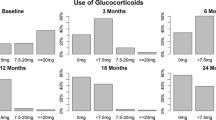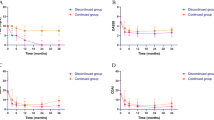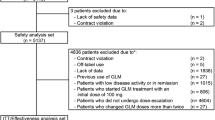Abstract
PF-04171327 is a dissociated agonist of the glucocorticoid receptor (DAGR) being developed to retain anti-inflammatory efficacy while reducing unwanted effects. Our aim was to conduct a longitudinal dose–response analysis to identify the DAGR doses with efficacy similar to or greater than prednisone 10 mg once daily (QD). The data included were from a Phase 2, randomized, double-blind, parallel-group study in 323 subjects with active rheumatoid arthritis on a background of methotrexate. Subjects received DAGR 1, 5, 10 or 15 mg, prednisone 5 or 10 mg, or placebo QD for 8 weeks. The Disease Activity Score 28-4 calculated using C-Reactive Protein (DAS28-4 CRP) was the efficacy endpoint utilized in this dose–response model. For DAGR, the maximum effect (Emax) on DAS28-4 CRP was estimated to be −1.2 points (95 % CI −1.7, −0.84), and the evaluated dose range provided 31–87 % of the Emax; for prednisone 5 and 10 mg, the estimated effects were −0.27 (95 % CI −0.55, 0.006) and −0.94 point (95 % CI −1.3, −0.59), respectively. Stochastic simulations indicated that the DAGR 1, 5, 10 and 15 mg have probabilities of 0.9, 29, 54 and 62 %, respectively, to achieve efficacy greater than prednisone 10 mg at week 8. DAGR 9 mg estimated probability was 50 % suggesting that DAGR ≥9 mg QD has an effect on DAS28-4 CRP comparable to or greater than prednisone 10 mg QD. This work informs dose selection for late-stage confirmatory trials.






Similar content being viewed by others
References
Feldmann M, Brennan FM, Maini RN (1996) Rheumatoid arthritis. Cell 85(3):307–310
Scott DL, Wolfe F, Huizinga TW (2010) Rheumatoid arthritis. Lancet 376(9746):1094–1108. doi:10.1016/S0140-6736(10)60826-4
Centers for disease control and prevention. Rheumatoid arthritis. http://www.cdc.gov/arthritis/basics/rheumatoid.htm. Accessed Feb 2015
Smolen JS, Aletaha D (2015) Rheumatoid arthritis therapy reappraisal: strategies, opportunities and challenges. Nat Rev Rheumatol. doi:10.1038/nrrheum.2015.8
Buttgereit F (2011) Do the treatment with glucocorticoids and/or the disease itself drive the impairment in glucose metabolism in patients with rheumatoid arthritis? Ann Rheum Dis 70(11):1881–1883. doi:10.1136/annrheumdis-2011-200388
Caplan L, Wolfe F, Russell AS, Michaud K (2007) Corticosteroid use in rheumatoid arthritis: prevalence, predictors, correlates, and outcomes. J Rheumatol 34(4):696–705
Criswell L, Saag K, Sems KM, Welch V, Shea B, Wells GA, Suarez-Almazor ME (2009) Moderate-term, low-dose corticosteroids for rheumatoid arthritis. Cochrane Database of Systematic Reviews (1998)
Kirwan JR, Bijlsma JWJ, Boers M, Shea B (2009) Effects of glucocorticoids on radiological progression in rheumatoid arthritis (Review). Cochrane Database of Systematic Reviews (2007)
Hu X, Du S, Tunca C, Braden T, Long KR, Lee J, Webb EG, Dietz JD, Hummert S, Rouw S, Hegde SG, Webber RK, Obukowicz MG (2011) The antagonists but not partial agonists of glucocorticoid receptor ligands show substantial side effect dissociation. Endocrinology 152(8):3123–3134. doi:10.1210/en.2010-1447
DAS28. Radboud University Nijmegen Medical Center. http://www.das-score.nl/das28/en/introduction-menu.html. Accessed Feb 2015
US FDA 2013 Guidance for Industry. Rheumatoid Arthritis: Developing Drug Products for Treatment. http://www.fda.gov/downloads/Drugs/GuidanceComplianceRegulatoryInformation/Guidances/UCM354468.pdf
American College of Rheumatology. 1987 Rheumatoid Arthritis Classification. http://www.rheumatology.org/Content.aspx?id=17435. Accessed April 2015
R Core Team (2013). R: A language and environment for statistical computing. R Foundation for Statistical Computing, Vienna, Austria. http://www.R-project.org/
Beal S, Sheiner LB, Boeckmann A, Bauer RJ. Nonlinear Mixed Effects Model Program (NONMEM) version 7.2.0, Icon Development Solutions, Ellicott City, MD, USA, 2011. http://www.iconplc.com/technology/products/nonmem
Lindbom L, Ribbing J, Jonsson EN (2004) Perl-speaks-NONMEM (PsN)–a Perl module for NONMEM related programming. Comput Methods Programs Biomed 75(2):85–94. doi:10.1016/j.cmpb.2003.11.003
Anderson JK, Zimmerman L, Caplan L, Michaud K (2011) Measures of rheumatoid arthritis disease activity: Patient (PtGA) and Provider (PrGA) Global Assessment of Disease Activity, Disease Activity Score (DAS) and Disease Activity Score with 28-Joint Counts (DAS28), Simplified Disease Activity Index (SDAI), Clinical Disease Activity Index (CDAI), Patient Activity Score (PAS) and Patient Activity Score-II (PASII), Routine Assessment of Patient Index Data (RAPID), Rheumatoid Arthritis Disease Activity Index (RADAI) and Rheumatoid Arthritis Disease Activity Index-5 (RADAI-5), Chronic Arthritis Systemic Index (CASI), Patient-Based Disease Activity Score With ESR (PDAS1) and Patient-Based Disease Activity Score without ESR (PDAS2), and Mean Overall Index for Rheumatoid Arthritis (MOI-RA). Arthritis Care Res 63(Suppl 11):S14–S36. doi:10.1002/acr.20621
Ward MM, Guthrie LC, Alba MI (2014) Clinically important changes in individual and composite measures of rheumatoid arthritis activity: thresholds applicable in clinical trials. Ann Rheum Dis. doi:10.1136/annrheumdis-2013-205079
Smithson M, Verkuilen J (2006) A better lemon squeezer? Maximum-likelihood regression with beta-distributed dependent variables. Psychol Methods 11(1):54–71. doi:10.1037/1082-989X.11.1.54
Conrado DJ, Denney WS, Chen D, Ito K (2014) An updated Alzheimer’s disease progression model: incorporating non-linearity, beta regression, and a third-level random effect in NONMEM. J Pharmacokinet Pharmacodyn 41(6):581–598. doi:10.1007/s10928-014-9375-z
SAGE Publications (2007) I Akaike Information Criterion. Encyclopedia of Measurement and Statistics. SAGE Publications, Inc, Thousand Oaks. doi:10.4135/9781412952644
Savic RM, Karlsson MO (2009) Importance of shrinkage in empirical bayes estimates for diagnostics: problems and solutions. AAPS J 11(3):558–569. doi:10.1208/s12248-009-9133-0
Milligan PA, Brown MJ, Marchant B, Martin SW, van der Graaf PH, Benson N, Nucci G, Nichols DJ, Boyd RA, Mandema JW, Krishnaswami S, Zwillich S, Gruben D, Anziano RJ, Stock TC, Lalonde RL (2013) Model-based drug development: a rational approach to efficiently accelerate drug development. Clin Pharmacol Ther 93(6):502–514. doi:10.1038/clpt.2013.54
Dickson MC, Ellis J, Cai G, Wilson AG, Bridges SL, Furst DE, O’Dell JR, El-Gabalawy HS, Tiffany C, Sidiqqi S, Bal J, Uings IJ, Blinks MH, Rioja I (2008) Corticosteroid-responsive pharmacodynamic transcriptional markers: results from a randomised placebo-controlled study of rheumatoid arthritis patients treated with prednisolone. https://acr.confex.com/acr/2008/webprogram/Paper2882.html. Paper presented at the American College of Rheumatology. Accessed Mar 2015
Inoue E, Yamanaka H, Hara M, Tomatsu T, Kamatani N (2007) Comparison of Disease Activity Score (DAS)28- erythrocyte sedimentation rate and DAS28- C-reactive protein threshold values. Ann Rheum Dis 66(3):407–409. doi:10.1136/ard.2006.054205
University of Missouri–Kansas City. Corticosteroid Conversion Table. http://med.umkc.edu/docs/em/Corticosteroid_Table.pdf. Accessed Mar 2015
Acknowledgments
DJC would like to acknowledge Gregory J. Hather (Pfizer Inc.) for his insightful comments on the statistical aspects. DJC also acknowledges William S. Denney (Pfizer Inc.) for his assistance with the R code. In addition, the authors would like to thank Jack Cook (Pfizer Inc.) for his valuable input to the manuscript.
Author information
Authors and Affiliations
Corresponding author
Ethics declarations
Conflict of interest
All authors are employees of Pfizer Inc. This study was sponsored by Pfizer Inc.
Electronic supplementary material
Below is the link to the electronic supplementary material.
Appendix: R code for stochastic simulations and calculation of probability of successful efficacy
Appendix: R code for stochastic simulations and calculation of probability of successful efficacy




Rights and permissions
About this article
Cite this article
Conrado, D.J., Krishnaswami, S., Shoji, S. et al. Predicting the probability of successful efficacy of a dissociated agonist of the glucocorticoid receptor from dose–response analysis. J Pharmacokinet Pharmacodyn 43, 325–341 (2016). https://doi.org/10.1007/s10928-016-9475-z
Received:
Accepted:
Published:
Issue Date:
DOI: https://doi.org/10.1007/s10928-016-9475-z




